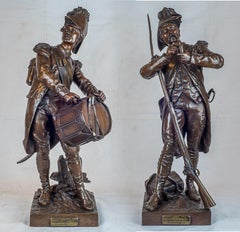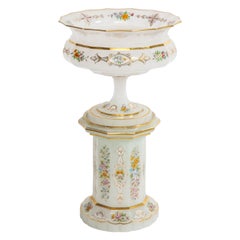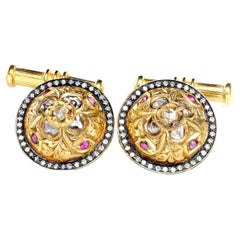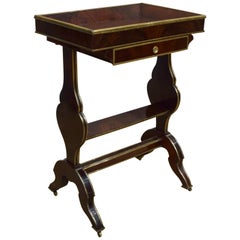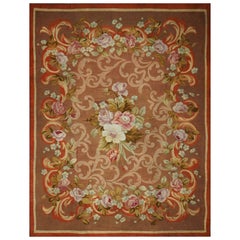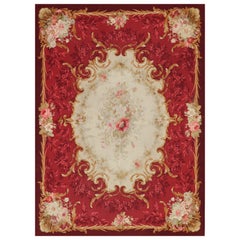Manhattan
to
58
977
15,393
9,782
88,825
62,817
39,647
22,794
17,527
12,442
8,806
6,301
5,382
5,201
4,468
4,454
4,211
3,980
3,875
2,731
2,727
1,889
1,501
1,224
1,129
977
849
786
761
404
394
316
232
192
186
167
165
157
124
79
69
54
49
49
45
40
39
39
36
31
17
10
9
8
7
7
6
6
5
5
4
4
2
2
1
21
11
10
10
9
Period: Mid-19th Century
Period: 1860s
Avant Le Combat, Apres Le Combat
Located in New York, NY
ÉTIENNE-HENRI DUMAIGE
French, (1830-1888)
Avant Le Combat, Apres Le Combat
Pair of patinated bronze; signed 'H. Dumaige' and titled ‘AVANT LE COMBAT, APRÈS LE COMBAT, GRENADIER D...
Category
1860s Manhattan
Materials
Bronze
Antique Bohemian White Opaline Centerpiece Resting on a White Opaline Plinth
Located in New York, NY
A rare hand-carved and faceted 19th century antique bohemian white opaline centerpiece resting on its original white opaline plinth. The opaline crystal is of the finest quality with...
Category
1850s Czech Other Antique Manhattan
Materials
Crystal
Antique Unisex 24k Gold "Kundan" Cufflinks with Natural Diamonds and Rubies
Located in New York, NY
An antique pair of unisex 24K gold "Kundan" cufflinks set with natural diamonds and rubies.
The handmade cufflinks feature emerald-green Guilloché enamel over a floral pattern.
The "...
Category
Mid-19th Century Indian Medieval Antique Manhattan
Materials
Diamond, Ruby, 24k Gold
Russian 19th Century Mahogany Table
Located in New York, NY
Every contour and plane of this exquisite tray-top, mahogany table on wheels is outlined with glinting brass stringing — a hallmark of Russian cabinetry in the late 18th and early 19...
Category
1840s Russian Louis Philippe Antique Manhattan
Materials
Brass
19th Century - French Restoration Period - Handwoven Antique Aubusson Rug
By Aubusson Manufacture
Located in New York, NY
-French restoration period handwoven antique Aubusson rug,
-circa 1830
-wool
-290 x 240 cm / 9.5 x 7.87 ft
At Boccara Gallery, we have an important collection of Aubusson rugs from the 18th-20th century. The style developed in Aubusson is recognized today as one of the most influential of the European rug and tapestries History.
Workshops to produce Aubusson flat-woven rugs were established under the royal warrant in 1743 to manufacture pile carpets primarily for the nobility.
Many weavers who settled in France were Huguenots who had fled Spain during the Inquisition in the early 16th century. By issuing the edict of Nantes, Henry IV granted all non-Catholics freedom of worship, thereby protecting the carpet weavers in Aubusson. Aubusson weavers became the finest craftsmen in the world. Louis XIV’s influential Prime Minister Colbert established the long and hard...
Category
Mid-19th Century French Restauration Antique Manhattan
Materials
Wool
Mid 19th Century - Napoleon III Period - Antique Aubusson Wool & Silk Rug
By Aubusson Manufacture
Located in New York, NY
-Mid-19th Century Napoleon III Period Handwoven Antique Aubusson Wool &
-Material: wool & silk
-Dimensions: 155 x 144 cm; 5.1 x 4.7 ft
Boccara Gallery has an important collection of Aubusson rugs from the XVIIIth to the XXth centuries. The style developed in Aubusson is recognized today as one of the most influential of the European rug and tapestries History.
Workshops to produce Aubusson flat-woven rugs were established under the royal warrant in 1743 to manufacture pile carpets primarily for the nobility.
Many weavers who settled in France were Huguenots who had fled Spain during the Inquisition in the early sixteenth century. By issuing the edict of Nantes, Henry IV granted all non-Catholics freedom of worship, thereby protecting the carpet weavers in Aubusson. Aubusson weavers became the finest craftsmen in the world. Louis XIV’s influential Prime Minister Colbert established the long and hard...
Category
Mid-19th Century French Aubusson Antique Manhattan
Materials
Silk, Wool
Manchu Tartar
By Antoine-Louis Barye
Located in New York, NY
ANTOINE-LOUIS BARYE
French, (1796-1875)
Manchu Tartar
Patinated Bronze; Signed BARYE on base
21 x 8 1/2 inches
Category
Mid-19th Century Manhattan
Materials
Bronze
Important Museum 19th C French Still Life Oil Painting Jenny Villebesseyx
Located in Exton, PA
Fine 19th century still life painting by an important French female painter Jenny Villebesseyx (1847 - 1924). The painting is oil on canvas measuring 23" x 29 1/2". Framed dimension...
Category
1860s Barbizon School Manhattan
Materials
Oil
Pair of French Porcelain Green and Salmon Ground Portrait Vases, circa 1850
Located in New York, NY
With fine gilding and gilt swan handles. The portraits with beautifully detailed portraits.
Category
1850s French Antique Manhattan
Materials
Porcelain
Large Austrian Silver Table Mirror, circa 1860
Located in New York, NY
Large Austrian silver table mirror, circa 1860.
Category
1860s Austrian Antique Manhattan
Materials
Bronze
Antique European Flatweave Rug
Located in New York, NY
Antique European Flatweave circa 1850 France.
Category
Mid-19th Century French French Provincial Antique Manhattan
Materials
Wool
Mid-20th Century Moroccan Tuareg Mat
Located in New York, NY
Morocco, circa mid-20th century
Measures: 8'2" x 4'8" (249 x 142 cm)
Handwoven.
Category
Mid-19th Century Moroccan Tribal Antique Manhattan
Materials
Leather, Reed
Mid 19th Century - Aubusson Rug - French Antique Design - Red with Floral
By Aubusson Manufacture
Located in New York, NY
Mid-19th century handwoven antique Aubusson rug
Material: wool
Dimensions: 260 x 200 cm; 8.5 x 6.6 ft
Boccara Gallery has an important collection of Aubusson rugs from the XVIIIth to the XXth centuries. The style developed in Aubusson is recognized today as one of the most influential of the European rug and tapestries History.
Workshops to produce Aubusson flat-woven rugs were established under the royal warrant in 1743 to manufacture pile carpets primarily for the nobility.
Many weavers who settled in France were Huguenots who had fled Spain during the Inquisition in the early sixteenth century. By issuing the edict of Nantes, Henry IV granted all non-Catholics freedom of worship, thereby protecting the carpet weavers in Aubusson. Aubusson weavers became the finest craftsmen in the world. Louis XIV’s influential Prime Minister Colbert established the long and hard...
Category
Mid-19th Century French Napoleon III Antique Manhattan
Materials
Wool
Set of Six Botanical Prints
Located in New York, NY
These colored engravings are from Edward Joseph Lowe's 1861 book "Beautiful Leaved Plants. Being a Description of the Most Beautiful Leaved Plants ...
Category
1860s Manhattan
Materials
Laid Paper, Engraving
A Highly Rare Pair of Monumental Qing Dynasty Rouleau Porcelain "Dragon" Vases
Located in New York, NY
A Highly Rare Pair of Monumental Qing Dynasty Rouleau Porcelain "Dragon" Vases
A Masterful Display of 19th Century Chinese Artistry:
The mid-19th century Qing Dynasty marked a period of artistic innovation and imperial grandeur, as exemplified by this rare and monumental pair of Rouleau vases. These exceptional porcelain works, notable for their commanding size and vibrant palette, are a testament to the unparalleled craftsmanship that flourished during this era. Embellished with a dynamic tableau of dragons rendered in bold hues of red, green, blue, brown, and yellow, these vases embody both artistic brilliance and the deep cultural symbolism woven into Chinese decorative arts.
Artistic Excellence and Symbolism:
At the heart of these magnificent vases lies a visual narrative that channels the power and mystique of the dragon, a central motif in Chinese culture symbolizing imperial authority, strength, and cosmic energy. The intricate depiction of dragons in motion, intertwined amidst stylized ocean waves, conveys a sense of fluidity and dynamic movement. Each color used—the crimson reds, verdant greens, striking blues, earthy browns, and golden yellows—has been meticulously applied, reflecting a mastery of the high-fired, polychrome enameling techniques perfected during the Qing Dynasty.
The Rouleau form, with its cylindrical body, short neck, and slightly flared mouth, was a favored shape for large-scale vases in the 18th and 19th centuries. The form’s structured elegance allowed for expansive decorative panels, serving as an ideal canvas for intricate, multi-layered designs. This pair demonstrates how artisans skillfully balanced the flowing movement of the dragons with the rhythmic motifs of waves, resulting in a harmonious composition that engages the viewer from every angle.
Craftsmanship and Technique:
These vases represent the pinnacle of porcelain artistry achieved under the Qing Dynasty, showcasing techniques that reflect centuries of refined craftsmanship. The precision in the application of overglaze enamels and the expert manipulation of kiln temperatures to achieve vibrant and consistent coloration are indicative of the expertise within the imperial kilns. The dragons' scales, rendered with remarkable detail, create a textured effect that contrasts beautifully with the smooth, undulating waves, enhancing the three-dimensional quality of the design.
The depth of color and the crisp delineation of each element point to a rigorous and time-intensive process. These qualities signify the involvement of highly skilled artisans who adhered to the imperial standards set by the royal court, ensuring that each piece was a fitting representation of the empire’s wealth and cultural prowess.
Historical and Cultural Significance:
Vases of this caliber were not merely decorative; they were imbued with profound symbolic meaning and often commissioned for imperial use or gifted as prestigious diplomatic offerings. The dragon motif, deeply embedded in Chinese folklore and philosophy, was associated with the emperor himself—known as the "Son of Heaven"—and symbolized his divine right to rule. These vases also reflect the Qing Dynasty's flourishing export trade and the global fascination with Chinese porcelain during the 19th century. European collectors and royal patrons prized such pieces for their artistry and the exoticism they represented, contributing to a legacy that elevated Chinese porcelain to a revered status in the annals of decorative art history.
Provenance and Collectability:
The extraordinary scale, exceptional craftsmanship, and rarity of this pair establish them as museum-quality works. Such vases would have held a place of honor in a palace or wealthy estate, reflecting not only the owner’s status but also an appreciation for the profound cultural and artistic traditions of China. Their provenance—potentially tied to an imperial commission or significant historical collection—underscores their importance as objects of study and admiration.
Provenance:
Private American Collection, acquired in London, circa 1905.
Thence by descent to the current owners
Solomon Treasure...
Category
Mid-19th Century Chinese Qing Antique Manhattan
Materials
Porcelain
Kipp Soldwedel Operation Statue of Liberty Oil Painting
By Kipp Soldwedel
Located in New York, NY
Kipp Soldwedel (American 1913-1999) "Operation Liberty" Statue of Liberty Oil on Canvas
The artist painted this work for the 100th Anniversary of the Stat...
Category
Mid-19th Century Manhattan
Materials
Oil
Large Antique, French Empire Style, Neoclassical Silvered Bronze Chandelier
Located in New York, NY
A large antique French Empire style silvered bronze multi light chandelier embellished with neoclassical motifs.
Category
Mid-19th Century French Empire Antique Manhattan
Materials
Bronze
